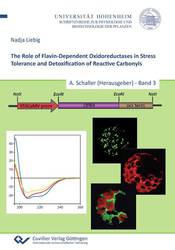| Departments | |
|---|---|
| Book Series (96) |
1378
|
| Nachhaltigkeit |
3
|
| Gesundheitswesen |
1
|
| Humanities |
2365
|
| Natural Sciences |
5406
|
| Mathematics | 229 |
| Informatics | 319 |
| Physics | 980 |
| Chemistry | 1363 |
| Geosciences | 131 |
| Human medicine | 243 |
| Stomatology | 10 |
| Veterinary medicine | 108 |
| Pharmacy | 147 |
| Biology | 835 |
| Biochemistry, molecular biology, gene technology | 121 |
| Biophysics | 25 |
| Domestic and nutritional science | 45 |
| Agricultural science | 1004 |
| Forest science | 201 |
| Horticultural science | 20 |
| Environmental research, ecology and landscape conservation | 148 |
| Engineering |
1793
|
| Common |
98
|
|
Leitlinien Unfallchirurgie
5. Auflage bestellen |
|
Advanced Search
The Role of Flavin-Dependent Oxidoreductases in Stress Tolerance and Detoxication of Reactive Carbonyls (Volume 3) (English shop)
Nadja Liebig (Author)Preview
Extract, PDF (1000 KB)
Table of Contents, PDF (160 KB)
Kurzbeschreibung
Die Familie der Oxophytodiensäurereduktasen (OPR) in Arabidopsis thaliana besteht aus 6 Mitgliedern. Außer OPR3, das ein Schlüsselenzym in der Jasmonsäurebiosynthese ist, scheinen die OPRs in den Detoxifizierungsprozess von Lipidperoxidationsprodukten bei abiotischem Stress involviert zu sein.
Die Funktionsverlustmutanten von OPR1, 2 und 4 zeigen deutliche Schädigungen unter Starklichtstress, wohingegen die genetische Komplementation zu wildtypischen Verhältnissen führt, was eine Rolle bei Starklichstress bestätigt. Zudem akkumulieren zahlreiche Stress verwandte Metaboliten in den opr-Mutanten. OPR4 besitzt außerdem eine Seneszenz fördernde Funktion. OPR1 und 2 sind im Cytosol lokalisiert und können die Doppelbindung von, durch Lipidperoxidation entstandenen, α,β-ungesättigten Carbonylen in vitro reduzieren. Heterolog exprimiertes OPR4, auf der anderen Seite, ist kaum löslich und besitzt keine katalytische Aktivität. Seine Relokalisation in Processing Bodies bei Stress bestätigt jedoch seine Stress verwandte Funktion.
Description
The oxophytodienoic acid reductase (OPR) family in Arabidopsis thaliana consists of six members. Except from OPR3, which is a key regulator in jasmonic acid biosynthesis, the OPRs seem to be involved in the detoxification of lipid peroxidation products during abiotic stress.
The loss-of-function mutants of OPR1, 2 and 4 are highly sensitive to highlight stress and genetic complementation of these mutants restore wild-type levels, confirming a role in high-light stress tolerance. In addition, several stress-related metabolites accumulate in the opr mutants. OPR4 has also a senescence promoting function. OPR1 and 2 are localized in the cytosol and are able to reduce the double bond of lipid peroxidation-derived α,β-unsaturated carbonyls in vitro. OPR4, on the other hand, is hardly soluble when expressed heterologously and possesses no catalytic activity. However, its relocalization to processing bodies after stress proves its stress-related function.
| ISBN-13 (Hard Copy) | 9783954043569 |
| ISBN-13 (eBook) | 9783736943568 |
| Final Book Format | A5 |
| Language | English |
| Page Number | 194 |
| Lamination of Cover | glossy |
| Edition | 1. Aufl. |
| Book Series | Schriftenreihe zur Physiologie und Biochemie der Pflanzen |
| Volume | 3 |
| Publication Place | Göttingen |
| Place of Dissertation | Hohenheim |
| Publication Date | 2013-02-13 |
| General Categorization | Dissertation |
| Departments |
Biology
Biochemistry, molecular biology, gene technology |
| Keywords | abiotic stress, lipid peroxidation, detoxification, Arabidopsis thaliana, α,β-unsaturated carbonyls, Allgemeine Biologie, Botanik |








